The National Ski Areas Association (NSAA) reported on Wednesday preliminary results showing 60.4 million skier visits in the United States for the 2023-2024 ski season. While this was a significant drop from the prior season's record breaking 65.4 million figure representing a 7.6% decrease year over year, it was in fact the 5th highest figure they have reported since they started tracking visitation in 1979 and the second best season ever in the western half of the country.
The ski industry was challenged by the weather far and wide to start the season with low snow and warm temperatures causing a shortage of terrain and fresh snow which resulted in most ski areas across the country falling well behind projections for the Christmas week which is one of the three main holiday periods that drive large numbers of people to the slopes. While much of the western US recovered mid-season to stem the damage, the Northeast, Southeast, and Midwestern regions remained quite warm for the entire season.
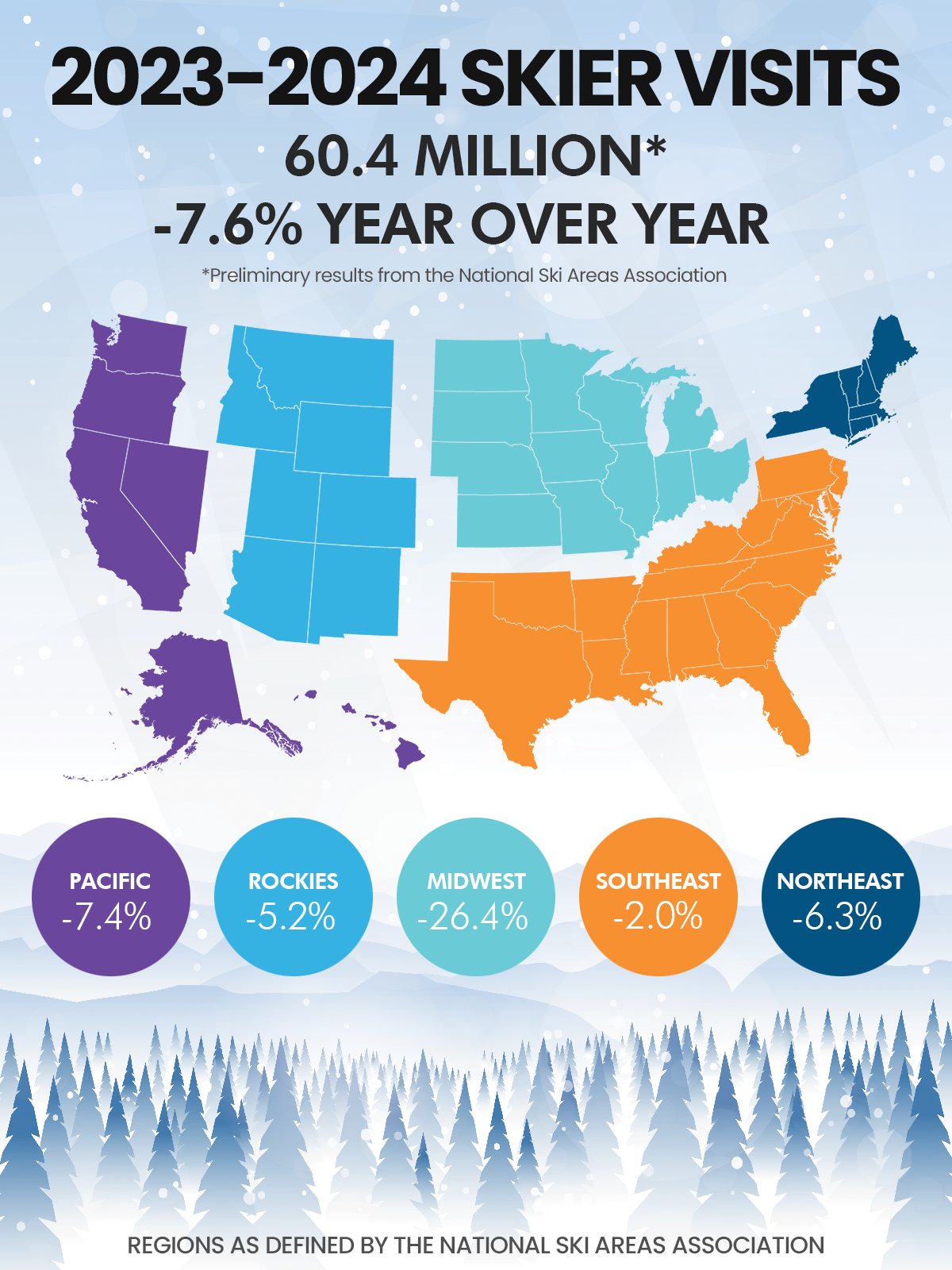
The Rockies recorded 26.7 million skier visits and despite the drop of 5.2% this was their second strongest season ever. We've combined NSAA regions of the Pacific Northwest and the Pacific Southwest into one Pacific region where they saw a combined 12.2 million skier visits and a drop of 7.4% over the prior season which was also the second best season ever for both combined in terms of visitation though the results in the Pacific Northwest were not as strong as the weather challenges were more notable in that region.
This was in fact the second season in a row that brought record and near record warm winter temperatures in the eastern half of the country, though this season the extreme anomalies crept further north and west into the heart of ski country. The Southeast only dropped 2% in visitation year over year to 4.2 million visits following a very tough prior season for operations. The Northeast region dropped by a somewhat more significant 6.3% from a strong but not record 13.2 million skier visits the prior season, down to 12.4 million this season. The Midwest however saw a dramatic reduction of 26.4% year over year with skier visits reaching just 4.8 million, less than half of their all time record visitation as they saw record warm temperatures over a large part of the region unlike the prior season leading to a much more notable drop year over year. Midwest ski areas are both generally small and numerous, and tend to lack the snowmaking infrastructure and budgets to deal with anomalies reaching up to 15F above normal. The region has seen a notable long-term trend of lower skier visits going back decades.
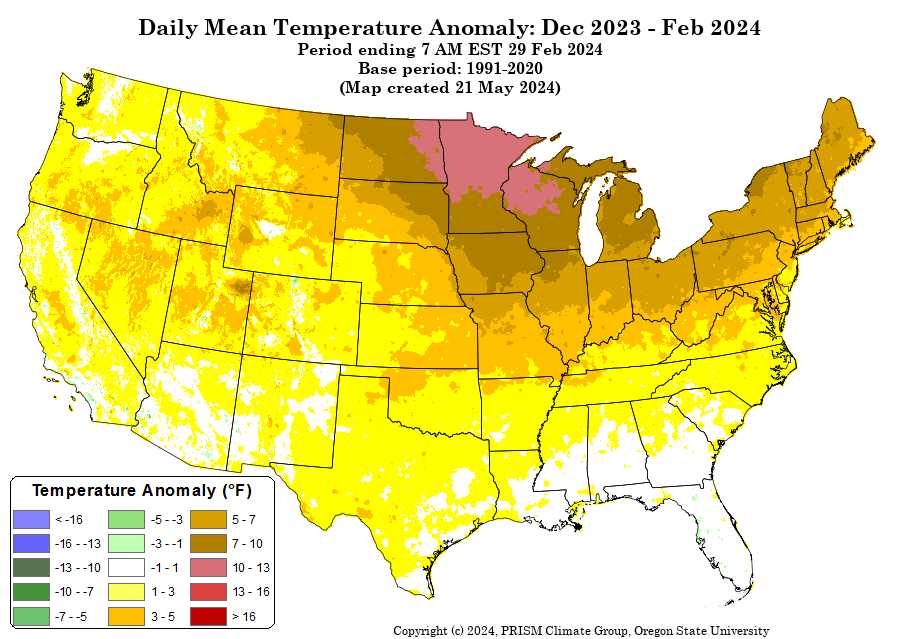
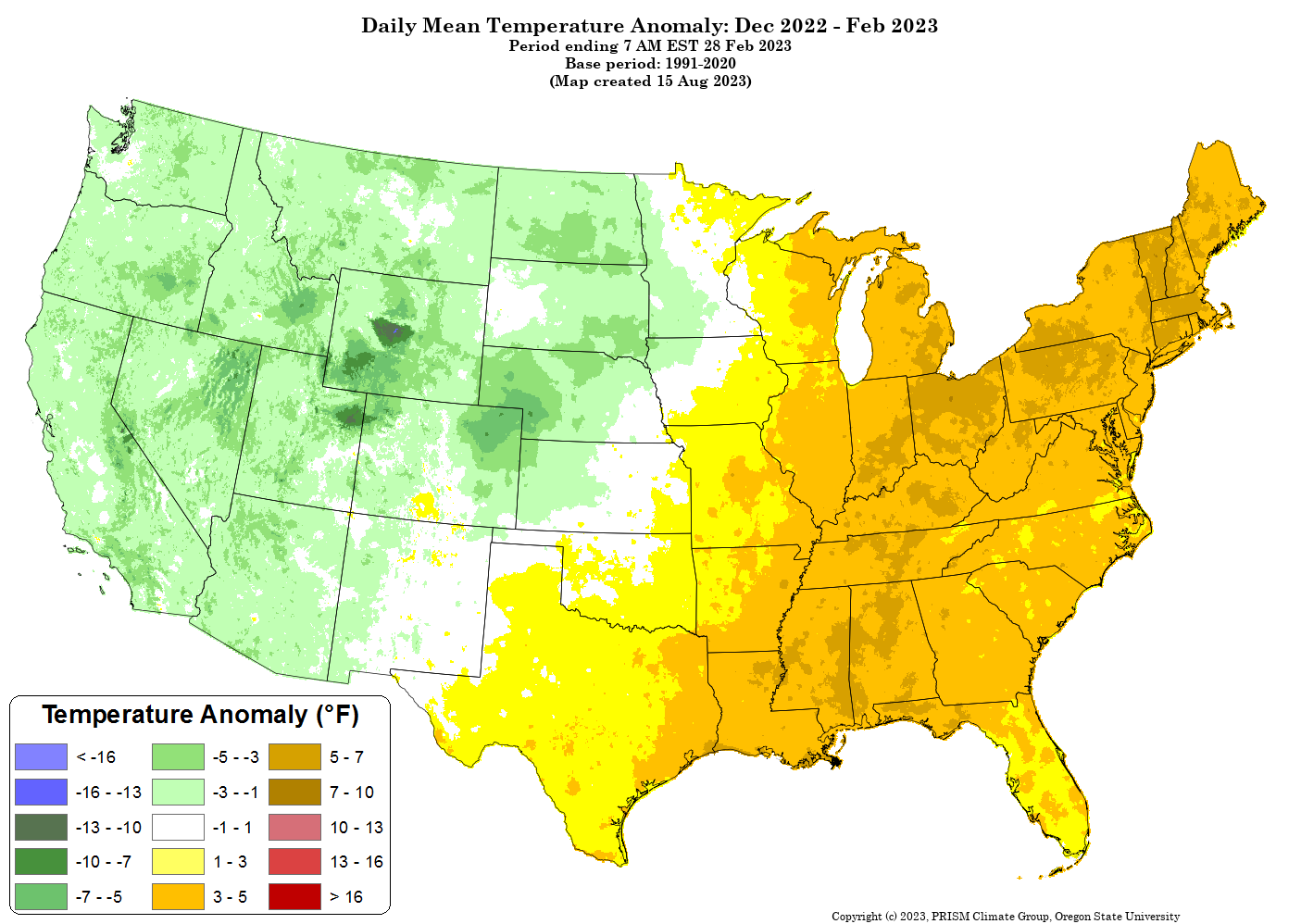
Winter 2022/2023 and 2023/2024 temperature anomalies provided by PRISM Climate Group, Oregon State University.
National Trends vs. Northeast Trends, A Tale of Two Worlds
Using NSAA's records of visitation since the 1994-1995 ski season we have prepared an analysis over the past 30 years showing both the trend line and a 10 year moving average, though we removed the COVID shortened 2019-2020 season as that data was anomalous.
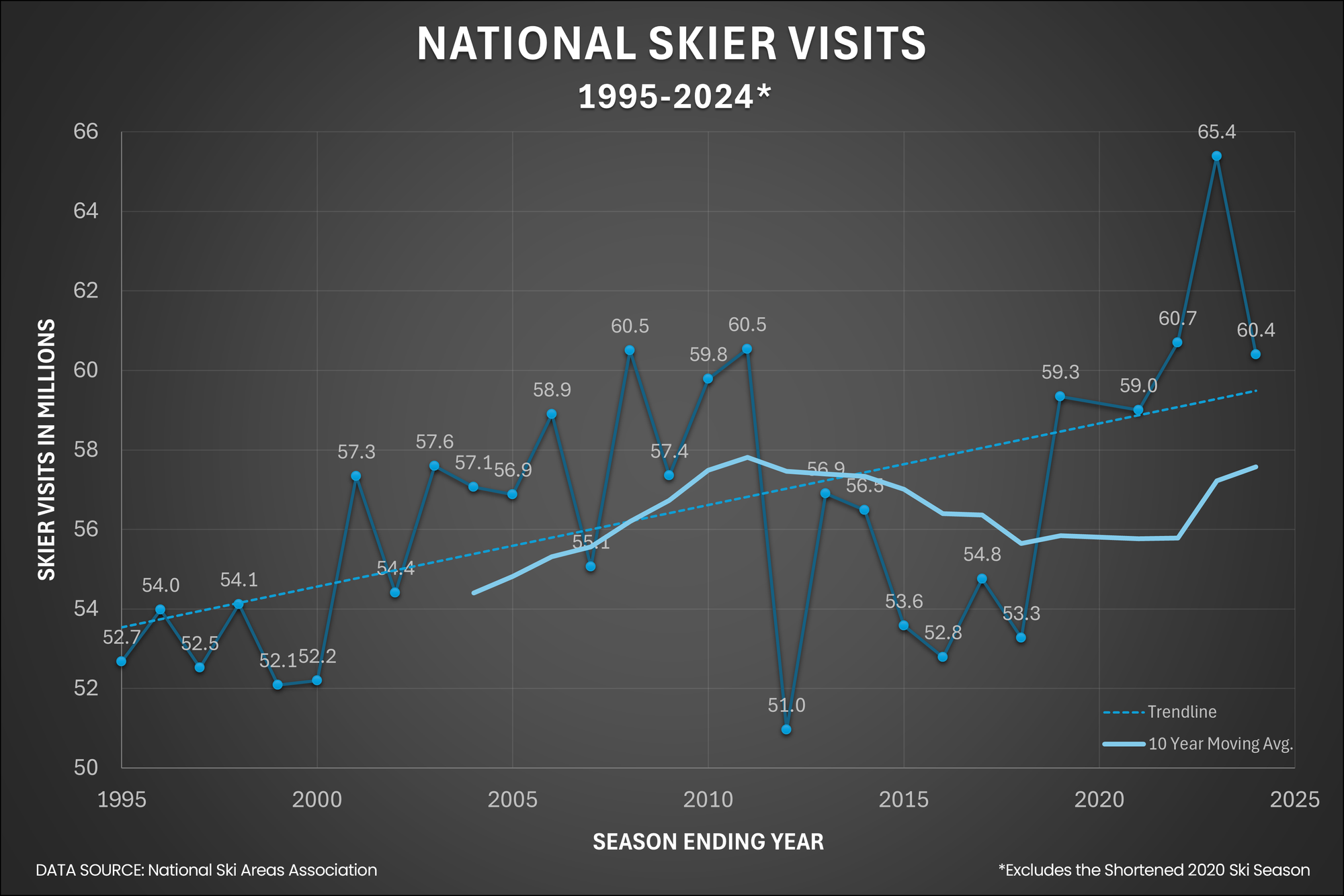
In the last 30 years the national trend for skier visits has increased from approximately 53.5 million in the season ending in 1995 to 59.5 million in 2024, an increase of 6 million or about 200,000 skier visits per season with this season over performing the trend by about 1.5%. The 60.4 million skier visits was 4.7% above the more sensitive 10 year moving average for visitation which currently sits at about 57.7 million suggesting increasing rates of growth.
The ski industry as a whole is certainly stronger and more resilient than ever with over-performance even in a widely warm and below average snowfall year that was also faced with economic challenges triggered by high rates of inflation. It's clear that the M.A.X. Pass and then Ikon Pass expanding into the Northeast starting in the 2017/2018 season followed by Vail Resorts purchasing Stowe in 2017 and expanding their offering in 2018 with the purchase of Triple Peaks (Okemo, Sunapee, and Crested Butte), then Peak Resorts in 2019, and Seven Springs and their two sister properties in 2021 have changed the landscape of the industry and increased overall participation. The Indy Pass also has grown in popularity resulting in some additional gains among small to medium ski areas.
Much of the growth the industry has seen however has been in the western states, and most notably Colorado, the Salt Lake City region, and the Tahoe region. The following chart displays the same 30 years in the Northeast region of New York and New England, and it shows a different story.
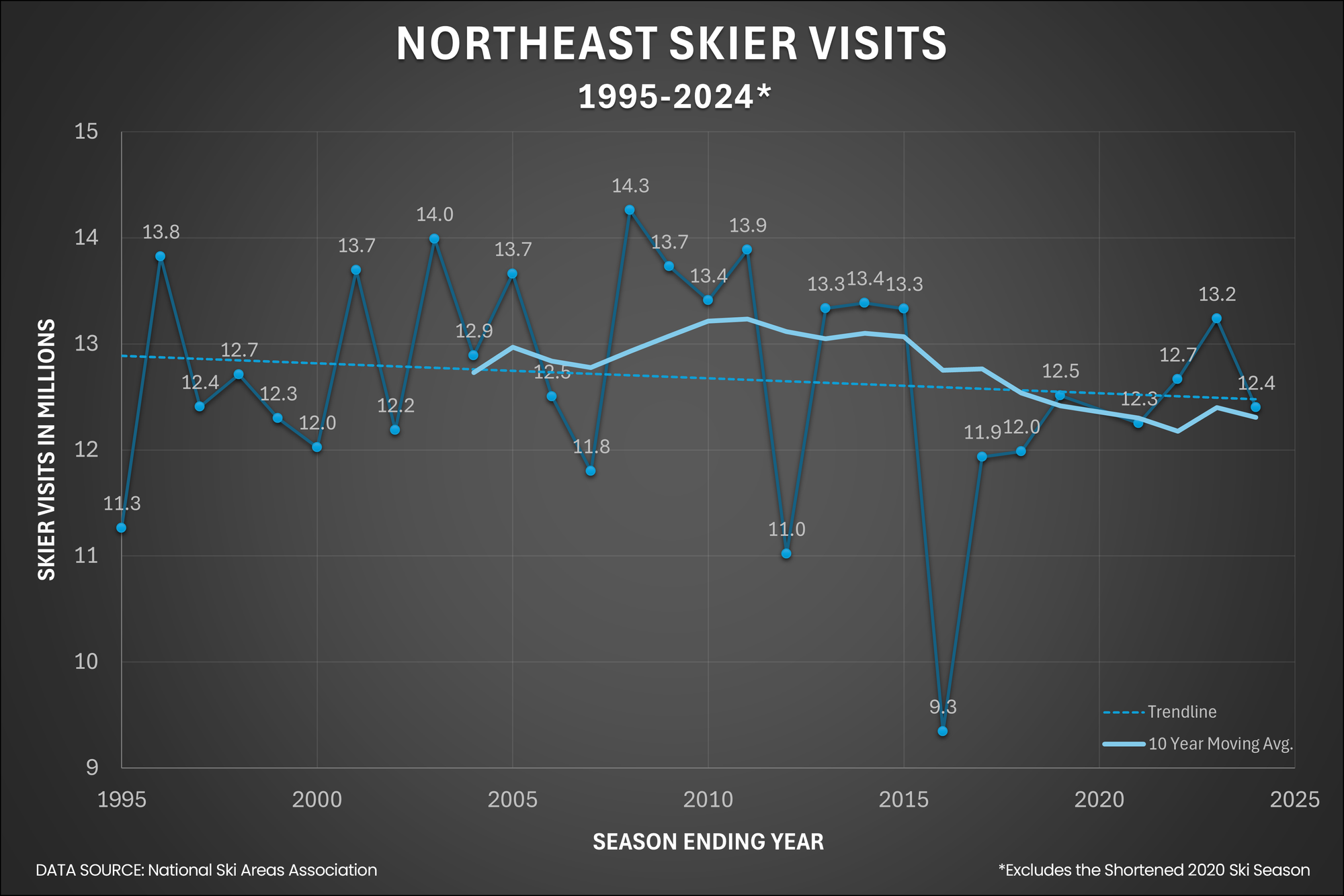
The trend for the last 30 years in the Northeast shows a drop from approximately 12.9 million skier visits in the 1994/1995 season to about 12.5 million this season, about 400,000 skier visits less representing a modest annual decrease of about 13,000 skier visits per season. The 10 year moving average also reinforces that slightly negative trend, but this was notably influenced by the pre-multi-pass Super El Nino season of 2015/2016 and seems to otherwise be improving in recent years outside of the effects of weather.
With the proliferation of cheap multi-passes across the Northeast, which are known to encourage higher levels of visitation, why isn't the region benefitting as much as the West? The chief reason for this is without doubt climate change.
This was the second season in a row where record or near record mean temperatures were seen in parts of the Northeast, and snowfall was widely below average as a result except in some higher elevations of northern areas. Ski areas across the entire region struggled to open terrain for the all important Christmas week as we saw a series of large storms fed by atmospheric rivers bringing extreme amounts of rain to the region in December. Over winter ski areas across the Northeast averaged generally from 5F to 10F above normal, and while it did start to snow more reliably in January, most of the snow fell only at the highest elevations in the most northern latitudes and many struggled to build natural snowpack due to the warmth.
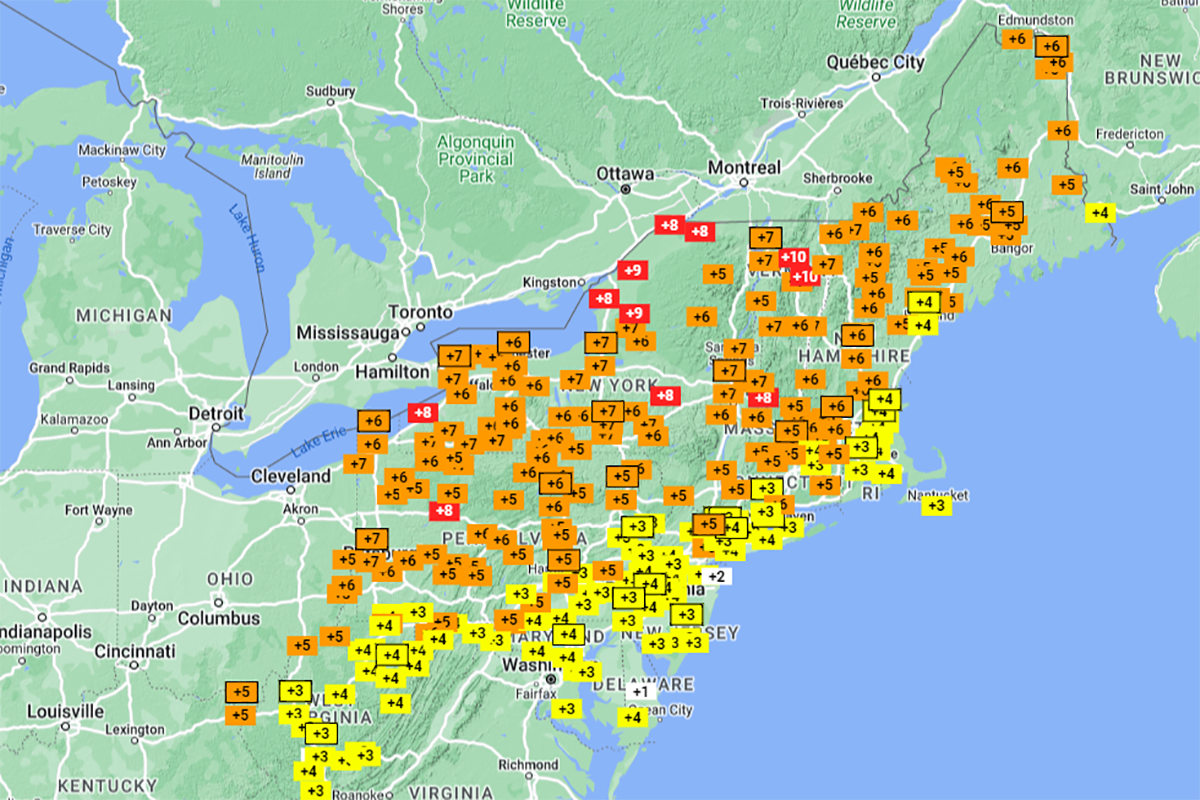
These anomalies are based on the trailing 3 decade average from 1991-2020, but this is on top of the warming that has already occurred and is cumulative. Many ski areas were in fact 10F to 15F above what would have been normal 50 years ago in the 1970's.
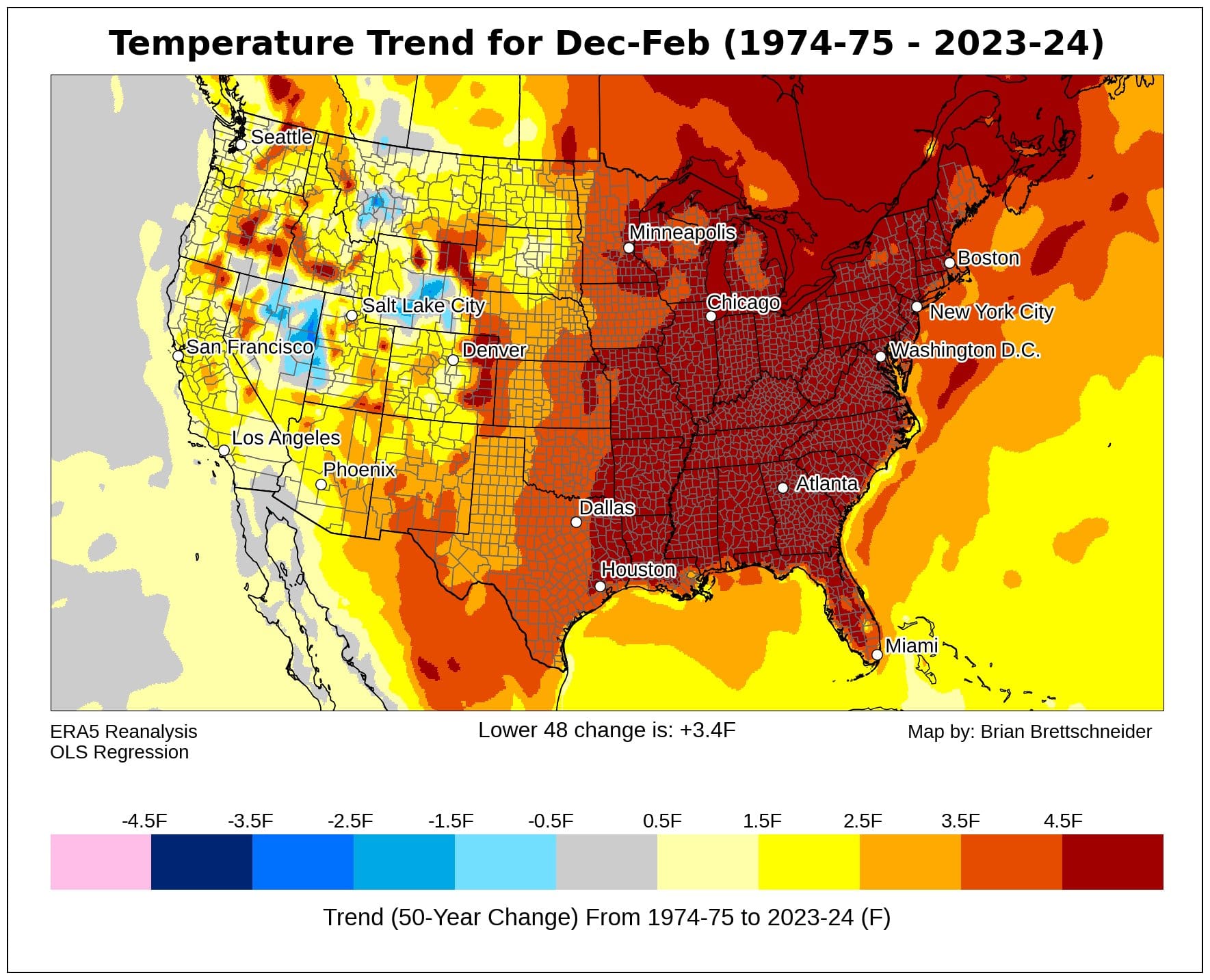
While ski areas have been combating this continually with investments in snowmaking, seasons are now getting shorter and Christmas is no longer a reliable driver of business for many in the Northeast as they struggle in the early season to build out terrain. It also doesn't help that it often no longer feels like winter along the Northeast Corridor stretching from Washington D.C. to Boston which is where most Northeast skiers and riders live.
It is testament however to the new focus on pass sales that the Northeast still had an average ski season despite the challenges. The Northeast saw a drop of 29.9% to well below the trendline in the strong El Nino season of 2015/2016 following a good winter, but just a 6.3% drop this season to the long-term trend in what was one of the warmest winters ever for the region. Driving more skiers and riders to purchase passes and other advance commitment products clearly helped stem the damage from bad weather.
Other Challenges Beyond the West
There are other challenges beyond the weather which are disproportionately affecting the Northeast, Midwest, and Southwest, most notably slower growing and increasingly older populations, and an increase in travel to western destinations with the proliferation of multi-passes, and a change to more accurate reporting of visitation.
The Northeast suffers from larger demographic challenges than all other regions. In the past 30 years the population of the New York and New England region (which NSAA considers the Northeast) has only grown by 3.7 million while the western states have grown their populations by 20.6 million during this same period with especially rapid growth in areas like Colorado and Utah which have experienced some of the largest increases in visitation. Skiing and riding are not in fact getting more popular as a percentage of the population, but population growth is clearly benefiting the West more than the Northeast and there are no signs of that changing anytime soon. The Northeast region's median age is now 40.6 years, the oldest region in the nation. Northeast skiers and riders are aging out more rapidly than they are being replaced by younger generations and much of the population growth is coming from immigration while younger generations are seeking opportunity in more rapidly growing regions of the country.
Multi-passes are also a bit of a double-edged sword. Epic and Ikon passes may be increasing visitation in the West by Northeasterners more than they are increasing visitation in the Northeast, and that is certainly the strategy. People spend far more money when they travel to a destination halfway across the country than they do when they day trip from their home, and these passes are designed to appeal to skiers and riders at home so that they will be more likely to buy a plane ticket, rental car, lodging, food, lessons, etc. out West. When people travel more to western destinations they aren't skiing and riding at home, so the effect of the popularity of these passes is muted in the Northeast and oversized in the West by design.
The Midwest and Southeast however have not seen their ski industries change dramatically as a result of the proliferation of multi-passes and strategies to lock people in ahead of the season with advance purchase products. This is likely why the effects of a warm winter this season in the Midwest were so dramatic, and the Southeast remains down by about 30% from their highs just 15 years ago as warm seasons become more common on top of already marginal temperatures. The long-term trends in these regions are very troubling.
It is certainly also possible that with the change from wicket tickets to scanned and then RFID tickets beginning in the 2010s that some of the drops in skier traffic were due to previous overestimates of pass usage and even intentional inflation of visitation when such numbers were more widely public. The ski industry has a history of overreporting various metrics from snow, to vertical, to acreage, to trail counts, and even visitation, but to a lesser extent in recent times.
So while the ski industry is overall stronger and more resilient than ever, it's a tale of two worlds as regions like the Northeast, Midwest, and Southeast are much more prone to the effects of climate change while facing demographic challenges and see far less benefit from destination skiers and riders. The industry would benefit from creating more skiers and riders near their homes and more focus on these regions would be beneficial to the entire industry.



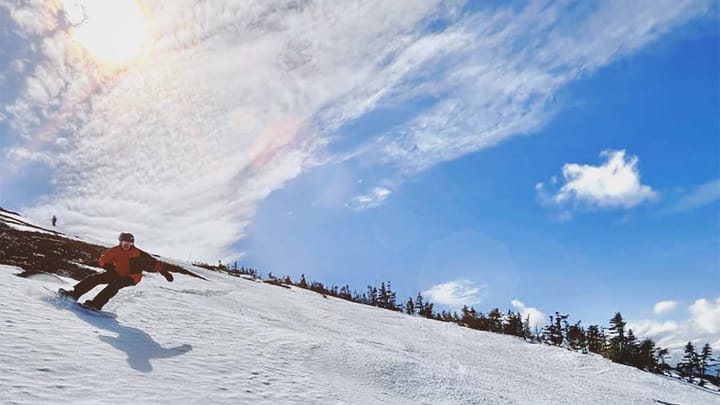
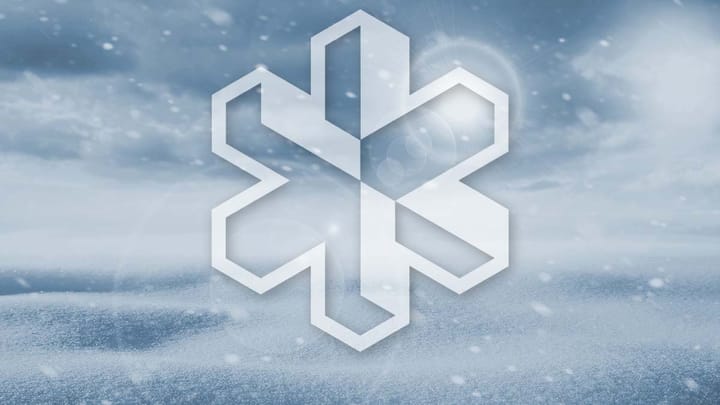
Comments ()